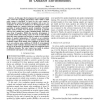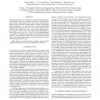193 search results - page 11 / 39 » Sparseness Achievement in Hidden Markov Models |
ICML
2009
IEEE
14 years 10 months ago
2009
IEEE
Sparsity is a desirable property in high dimensional learning. The 1-norm regularization can lead to primal sparsity, while max-margin methods achieve dual sparsity. Combining the...
IMCSIT
2010
13 years 4 months ago
2010
In this paper the development of a prototypic mobile voice control for navigating autonomous robots within a multi robot system is described. As basis for the voice control a hidde...
JMLR
2010
13 years 4 months ago
2010
Real stochastic processes operating in continuous time can be modeled by sets of stochastic differential equations. On the other hand, several popular model families, including hi...
ICASSP
2011
IEEE
13 years 1 months ago
2011
IEEE
This paper presents a novel method for reducing the dimensionality of kernel spaces. Recently, to maintain the convexity of training, loglinear models without mixtures have been u...
ICCV
2009
IEEE
15 years 2 months ago
2009
IEEE
Partially occluded faces are common in many applications
of face recognition. While algorithms based on sparse
representation have demonstrated promising results, they
achieve t...


